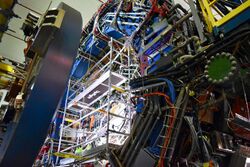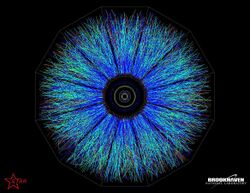Biography:Helen Caines
Helen Caines | |
|---|---|
| Born | Helen Louise Caines |
| Alma mater | University of Birmingham (BSc, PhD) |
| Known for | Quark–gluon plasma |
| Scientific career | |
| Institutions | Yale University Ohio State University |
| Thesis | A study of strangeness production in Pb-Pb collisions at 158GeV nucleon (1996) |
| Website | physics |
Helen Louise Caines FInstP is a Professor of Physics at Yale University. She studies the quark–gluon plasma and is the co-spokesperson for the STAR experiment.
Education
Caines studied physics at the University of Birmingham and graduated in 1992.[1] She earned her PhD at the University of Birmingham in 1996.[2][3]
Career and research
In 1996 she joined Ohio State University.[4][5] She was elected a junior representative of the STAR experiment in 1998.[6] Caines was appointed to Yale University in 2004.[6] She studies the quark–gluon plasma, working alongside John Harris.[7][8] She uses heavy-ion experiments to study quantum chromodynamics in extreme conditions.[9] She studies the quark–gluon plasma.[7] Her measurements indicated the quark–gluon plasma is the most vortical fluid ever known.[10] In 2005 she became a council member of the STAR experiment advisory board.[6] She investigated soft physics.[11] She was elected a fellow of the Institute of Physics in 2008.[6] She was promoted to Associate Professor with tenure in 2007.[12]
She developed the STAR detector, a solenoidal tracker to measure hadronic particle production.[13] She works on the Au-Au collisions at √sNN = 7.7 to 200 GeV.[14] They demonstrated that when two gold ions collide, negatively and positive charged particles flow out in a chiral magnetic effect.[15] She also looks at the product of two colliding ruthenium ions, which creates a strong magnetic field. Along with Zhangbu Xu, Caines was appointed co-spokesperson for the STAR experiment in 2017.[6][16] The STAR experiment is part of the Relativistic Heavy Ion Collider at Brookhaven National Laboratory.[6]
She served as a member for the Nuclear Science Advisory Committee at the United States Department of Energy from 2016. She contributes to the United States Long Range Plan for Nuclear Physics.[17][18][19] She has explored how artificial neural networks can be used to identify quark jets.[20] She serves as a member of the American Physical Society Education Committee.[21]
Caines taught a Being Human in STEM course at Yale University.[22] The class examines how socioeconomic background, gender, race, religion and sexuality shape the STEM experience.[22] The course was modelled on a similar program at Amherst College.[22]
Awards and honours
Caines was elected a fellow of the American Physical Society in 2018[23] and a Fellow of the Institute of Physics (FInstP).[when?] In 2003 she was awarded an Engineering and Physical Sciences Research Council advanced research fellowship.[1]
References
- ↑ 1.0 1.1 "Helen Caines". http://star.physics.yale.edu/~caines/CV/cv.html.
- ↑ Caines, Helen Louise (1996). A study of strangeness production in Pb-Pb collisions at 158GeV nucleon (PhD thesis). University of Birmingham. OCLC 911151465. Copac 911151465.
- ↑ "Helen Caines | Department of Physics" (in en). https://physics.yale.edu/people/helen-caines.
- ↑ "Nuclear Physics at Ohio State". 2011. https://www.physics.ohio-state.edu/~ntg/NucPhys_updated2011_full.pdf.
- ↑ "Recent Papers of the OSU Heavy Ion Group". http://www.physics.ohio-state.edu/~lisa/HIRG/papers.html.
- ↑ 6.0 6.1 6.2 6.3 6.4 6.5 Shelton, Jim (2017-07-12). "Yale's Helen Caines takes a leadership role in international experiment" (in en). https://news.yale.edu/2017/07/12/yale-s-helen-caines-takes-leadership-role-international-star-experiment.
- ↑ 7.0 7.1 "Helen Caines Bio". US Department of Energy. https://science.energy.gov/~/media/np/nsac/pdf/2016%20Member%20Bios/Caines_Bio.pdf.
- ↑ "Working for a more inclusive collaboration: Interview with John Harris". http://alicematters.web.cern.ch/?q=content/node/1072.
- ↑ Caines, Helen (2009). Heavy-Ion Collisions - Examining the Quark Gluon Plasma at RHIC. Bibcode: 2009arXiv0911.3211C. http://inspirehep.net/record/837130.
- ↑ Sanchez-Maes, Sophia (2018-01-17). "What's Hot, Dense, and Spins Like Crazy?" (in en-US). Yale Scientific Magazine. http://www.yalescientific.org/2018/01/whats-hot-dense-and-spins-like-crazy/.
- ↑ Caines, H. (2007). "Is soft physics entropy driven?" (in en). The European Physical Journal C 49 (1): 297–301. doi:10.1140/epjc/s10052-006-0109-2. ISSN 1434-6052. Bibcode: 2007EPJC...49..297C.
- ↑ Woodford, Antonia (April 3, 2012). "Seven professors awarded tenure" (in en). https://yaledailynews.com/blog/2012/04/03/seven-professors-awarded-tenure/.
- ↑ Caines, Helen (2003). "STAR results from the first year at RHIC" (in en). Pramana 60 (4): 627–638. doi:10.1007/BF02705163. ISSN 0973-7111. Bibcode: 2003Prama..60..627C.
- ↑ Caines, Helen (2014). "A Snapshot of our Experimental Knowledge Circa Winter 2012-13" (in en). Journal of Physics: Conference Series 509 (1): 012001. doi:10.1088/1742-6596/509/1/012001. ISSN 1742-6596. Bibcode: 2014JPhCS.509a2001C.
- ↑ "Relativistic heavy ion collider begins 18th year of experiments" (in en-us). https://phys.org/news/2018-03-relativistic-heavy-ion-collider-18th.html.
- ↑ "Relativistic Heavy Ion Collider Begins 18th Year of Experiments". Brookhaven National Laboratory. https://www.bnl.gov/newsroom/news.php?a=112738.
- ↑ Akiba, Yasuyuki; Angerami, Aaron; Caines, Helen; Frawley, Anthony; Heinz, Ulrich; Jacak, Barbara; Jia, Jiangyong; Lappi, Tuomas et al. (2015). The Hot QCD White Paper: Exploring the Phases of QCD at RHIC and the LHC. Bibcode: 2015arXiv150202730A.
- ↑ "The 2015 Long Range Plan for Nuclear Science". Nuclear Science Advisory Committee. http://hinp.physics.uoi.gr/Workshop_2016/1%20D.%20Bonatsos.pdf.
- ↑ "Department of Physics and Astronomy". http://www.physics.rutgers.edu/np/2007lrp-part-phase.html.
- ↑ "APS -2017 Fall Meeting of the APS Division of Nuclear Physics - Event - Identifying Jets Using Artifical [sic] Neural Networks". Bulletin of the American Physical Society (American Physical Society) 62 (11). http://meetings.aps.org/Meeting/DNP17/Session/EA.77.
- ↑ "Education Committee" (in en). https://www.aps.org/units/dnp/governance/committees/education.cfm.
- ↑ 22.0 22.1 22.2 Kan, Ellen (December 9, 2016). "Class examines inclusivity in STEM" (in en). https://yaledailynews.com/blog/2016/12/09/class-examines-inclusivity-in-stem/.
- ↑ "Helen Caines (Associate Professor of Physics) elected a Fellow of the American Physical Society | Department of Physics". https://physics.yale.edu/news/helen-caines-associate-professor-physics-elected-fellow-american-physical-society.
 |



